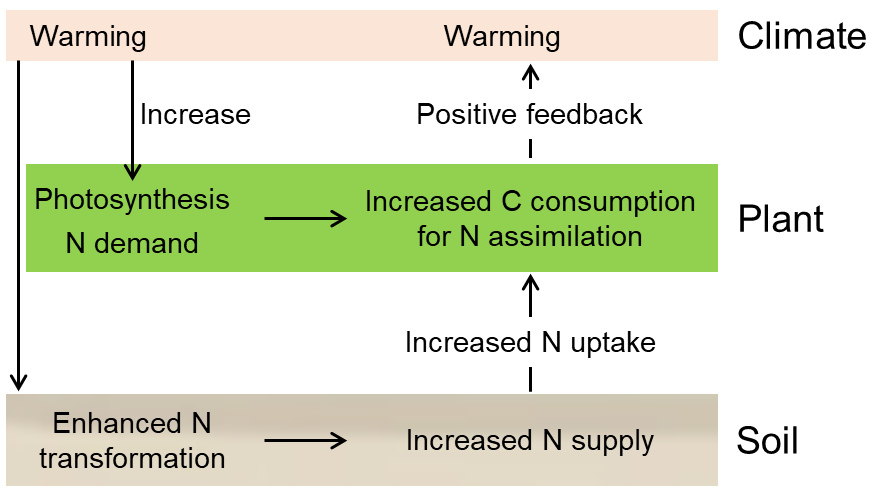Plant uptake of soil nitrogen (N) and internal N assimilation both require consumption of carbon (C) fixed by photosynthesis. Biochemical studies indicate that the theoretical C costs for plant assimilation of nitrate, ammonium, and dissolved organic N average 5.81, 4.32, and 2.16 g-C/g-N, respectively (Zerihun et al., 1998, New Phytologist, 138, 1-11).
Recently, LIU Xueyan’s research group developed a new plant-soil N isotope process model that quantified the fractional contribution of these three N forms to total N in global terrestrial plants (Hu et al., 2024, Nature Communications, 15, 6407). Based on this model, and by combining global data on terrestrial plant C/N and gross primary productivity (GPP), they estimated the gross C consumed for N assimilation by global terrestrial plant to be 208 ± 12 Tg-C/yr (Fig. 1). This value unexpectedly exceeds annual C emissions from forest fires and degradation (155 Tg-C/yr, Friedlingstein et al., 2023, Earth System Science Data, 15, 5301–5369) and is comparable in magnitude to forest C sequestration driven by atmospheric N deposition (240 Tg-C/yr, Nadelhoffer et al., 1999, Nature; 310 Tg-C/yr, Thomas et al., 2010, Nature Geoscience). Previous studies have mainly emphasized the positive effects of N on plant growth and C sequestration, while the metabolic C costs of plant N assimilation have lacked detailed assessment. This gap represents a long-standing “blind spot” in terrestrial C cycle research. Their findings indicate that this hidden C expenditure should be incorporated into C balance accounting.

Figure 1. Carbon consumption for nitrogen assimilation by global terrestrial plants and its response to climate warming
(G(i) represents the gross C consumption associated with the assimilation of total N (TN), nitrate (NO₃⁻), ammonium (NH₄⁺), and extractable organic N (EON) by global terrestrial plants. ΔC(TN) denotes the relative change in C consumption for TN assimilation under the 2.0℃ warming scenario compared with the present-day)
On the other hand, climate warming can enhance soil N transformations and increase the supply of bioavailable N, particularly inorganic forms such as nitrate and ammonium, as well as raise plant N demand due to accelerated growth. These changes may increase the proportion of inorganic N assimilated by plants and the associated C consumption, thereby elevating the total C cost of plant N assimilation (Fig. 2). To test this hypothesis, the researchers simulated the contributions of different N sources under 2.0℃ warming scenario, and combined with corresponding simulations of plant C/N and GPP (Tian et al., 2021, Global and Planetary Change, 205, 103588), estimated that the total C consumed for N assimilation by global terrestrial plants under this warming scenario would reach 249 ± 15 Tg-C/yr. This represents an average increase of 47% (41 ± 19 Tg C) compared with the present-day level (208 ± 12 Tg-C/yr), with increases of 9%, 62%, and 105% in tropical, temperate, and boreal regions, respectively (Fig. 1). Climate warming thus enhances soil inorganic N availability and its contribution to plant total N assimilation. However, it also increases the metabolic C expenditure associated with plant N assimilation, offsetting part of the photosynthetic C gain. This effect is particularly pronounced at high latitudes (Fig. 1).

Figure 2. Mechanisms of plant nitrogen assimilation and its carbon costs in response to climate warming
This study reveals new mechanisms of coupling between vegetation C-N cycling processes and their climate responses and feedbacks, providing novel evidence for refined accounting of the global C balance and for formulating future C-neutral and climate-response strategies. The paper was published in Nature Geoscience on October 6, 2025: Chao-Chen Hu, Chen-Guang Tian, Chong-Juan Chen, Wei Song, Xu Yue, Xue-Yan Liu*. (2025) Increased carbon cost for nitrogen assimilation in plants under a warming climate. Nature Geoscience, doi: 10.1038/s41561-025-01816-y. https://www.nature.com/articles/s41561-025-01816-y
Contact
LIU Xueyan
Institute of Geochemistry, Chinese Academy of Sciences
Email: liuxueyan@mail.gyig.ac.cn
(By Prof. LIU Xueyan’s group)